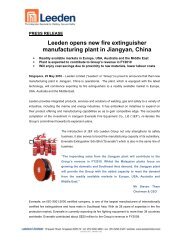Annual Report 2010 - Leeden Limited
Annual Report 2010 - Leeden Limited
Annual Report 2010 - Leeden Limited
Create successful ePaper yourself
Turn your PDF publications into a flip-book with our unique Google optimized e-Paper software.
A Stronger <strong>Leeden</strong> in Asia.Notes to the Financial Statementsfor the Financial Year ended 31 December <strong>2010</strong>37. Financial risk management objectives and policies (cont’d)(b)Foreign currency risk (cont’d)Sensitivity analysis for foreign currency riskThe following table demonstrates the sensitivity of the Group’s profit net of tax to a reasonably possible changein the USD, EUR and AUD exchange rates (against SGD), against the respective functional currencies of the Groupentities, with all other variables held constant.<strong>2010</strong> 2009Profit net of tax Profit net of tax$’000 $’000USD - strengthened 8% (2009: 3%) (92) 85- weakened 8% (2009: 3%) 92 (85)EUR - strengthened 15% (2009: 1%) (159) (13)- weakened 15% (2009: 1%) 159 13AUD - strengthened 4% (2009: 25%) (8) (85)- weakened 4% (2009: 25%) 8 85(c)Credit riskCredit risk is the risk of loss that may arise on outstanding financial instruments should a counterparty defaulton its obligations. The Group’s and the Company’s exposure to credit risk arises primarily from trade and otherreceivables.The Group trades only with recognised and creditworthy third parties. It is the Group’s policy that all customerswho wish to trade on credit terms are subject to credit verification procedures. In addition, receivable balances aremonitored on an ongoing basis with the result that the Group’s exposure to bad debts is not significant.With respect to credit risk arising from the other financial assets of the Group, which comprise trade and otherdebtors and cash and cash equivalents, the Group’s exposure to credit risk arises from the default of the counterparty, with a maximum exposure equal to the carrying amount of these instruments.The Group’s objective is to seek continual revenue growth while minimising losses incurred due to increased creditrisk exposure.Since the Group trades only with recognised and creditworthy third parties, there is no requirement for collateral.There are no significant concentrations of credit risk within the Group.Exposure to credit riskAt the balance sheet date, the Group’s and the Company’s maximum exposure to credit risk is represented bythe carrying amount of each class of financial assets recognised in the balance sheets, including derivatives withpositive fair values.Information regarding credit enhancements for trade and other debtors is disclosed in Notes 21 and 22.94





